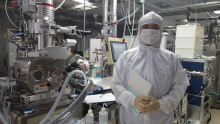
University:
Major:
Site Abroad:
Mentor(s):
Faculty Sponsor(s):
Project Title:
Project Description:
The focus of spin caloritronics is on the interaction of spin currents with heat currents. Resulting effects can be used to improve thermoelectric devices, recovering more power from waste heat. Dilute ferromagnetic semiconductors (FMS), traditional semiconductors doped with transition metal ions, are technologically interesting as they display both ferromagnetic and semiconducting properties, so studying their spin-caloritronic properties (as well as other magnetic and electric properties) is important for the development of more energy efficient electronic and spintronic devices. The work of this project includes the material characterization and study of spin-dependent effects in the n-type FMS (In,Fe)Sb, more specifically In1-xFexSb (x = 0.16) thin films on GaAs(001) substrates. Magnetic circular dichroism (MCD) measurements were used to observe the hysteresis indicating the ferromagnetism of the material and to estimate its Curie temperature. Additionally, using a Hall bar device, the anomalous Hall effect was observed by probing the Hall voltage with variation of the applied magnetic field, and the intrinsic resistance of the material was measured with variation of temperature. The central measurement of this work aimed to measure the spin-dependent thermopower of In0.84Fe0.16Sb. Upon application of a temperature gradient and an in-plane magnetic field, the voltage across a platinum strip deposited on the surface of the sample was probed. From angular-dependent and magnetic field-dependent measurements of this voltage, the magnitude of the planar Nernst effect (PNE) in the material was determined for set temperature, and new phenomena unrelated to the PNE or the spin Seebeck effect (SSE) was observed.
